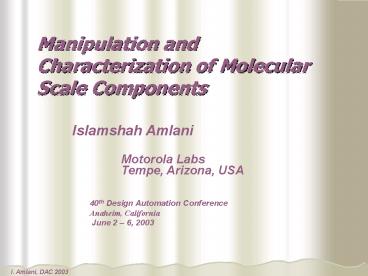Manipulation and Characterization of Molecular Scale Components - PowerPoint PPT Presentation
1 / 29
Title: Manipulation and Characterization of Molecular Scale Components
1
Manipulation and Characterization of Molecular
Scale Components
Islamshah Amlani
Motorola Labs Tempe, Arizona, USA
40th Design Automation Conference Anaheim,
California June 2 6, 2003
2
Emerging Technology Sequence
After ITRS 2001 Edition (http//public.itrs.net)
3
Why Molecular Electronics?
- Traditional scaling to sub 10 nm regime very hard
and too costly - CMOS technology needs a low cost ultra-low power
successor - Paradigm shift required for device technology and
system architecture - Molecular Electronics is a viable solution
4
Molecular Electronics Toolbox
5
Roadmap Milestones for ME
6
ME Memory/Logic Architectures
- Digital CMOS look-alikes
- Complimentary CNTFET
- Deterministic logic states (digital)
- Probabilistic logic states (quasi-analog)
- Cellular Automata
- Biologically Induced design (i.e. viral particle,
DNA) - Random Assembly, Software Configuration
- Others
7
ME Architecture
8
ME Architecture
9
How can we test small number of molecule for
molecular electronics applications?
10
Self Assembled Monolayers (SAM)
11
Molecular Test-bed
12
Molecular Test-bed
From Reed et al., Yale Univ. and Rice University
13
Hybrid Assembly Technique
14
AC Trapping of Au Nanoparticles
15
Hybrid Assembly Technique
16
Memory Effects using the Test Molecule
50
I (nA)
0
-50
0
1
2
-1
-2
V (V)
17
Carbon Nanotubes (CNTs)
18
Carbon Nanotubes (CNTs)
Various Forms of Carbon
Graphite
Nanotube
Buckyball C60
Diamond
From Smalley (Rice Univ.)
- Buckyballs discovered in mid 80s, but CNTs are
relatively new (early 90s). - Diameter 1 nm, but can be gt 1 µm long.
- Great electrical conductors -gt quantum wires.
- Ends can be chemically modified for selective
attachment to other molecules or nanoparticles. - Versatile building block for molecular
electronics.
19
CNT Circuits
20
CNT Circuits
21
CVD Grown CNT Devices
22
SWNT Devices via Selective Placement
23
Silicon MOSFET vs CNT FET
24
Various SET Systems
25
Single Electron Charging Effects
26
Small Gap SWNT Sample
27
Charging in p-type Region
- E add e2/CS DE 25 35 meV
- DE hvF/4L(linear dispersion relation) 6 meV
- Simple CBO model CS CS CD CG 7.9 aF,
e2/CS 20 meV - Transition between quantum to classical CB 50
100 K ? DE 4.5 8 meV
28
CBOs in n-type Region
Beating and peak splitting is observed in
metallic and semiconducting two-dot systems
29
(No Transcript)































